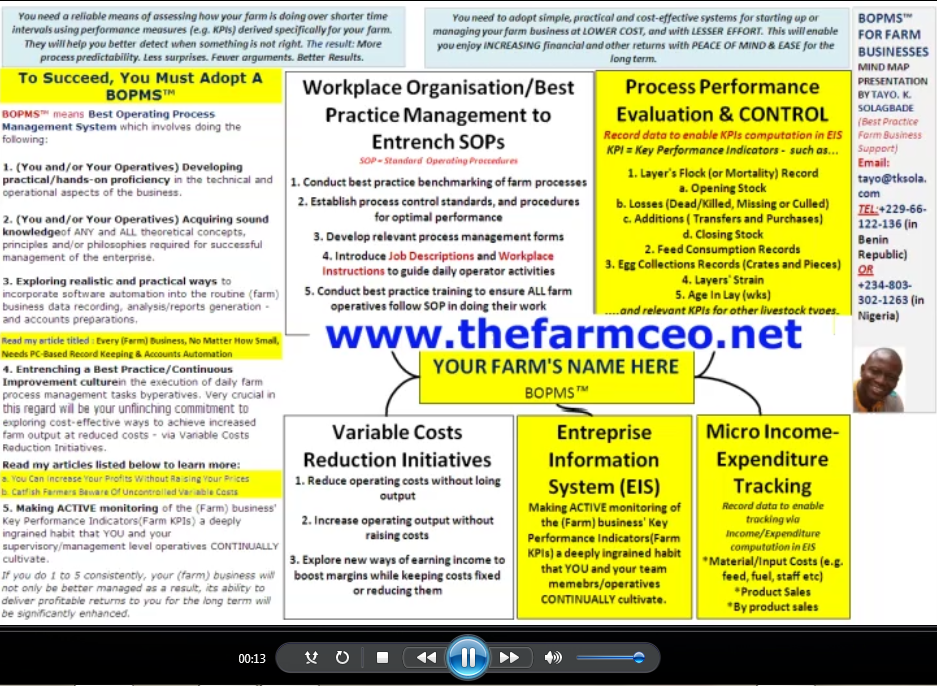lTIP: The mind map based video explanation now offered from this page is actually a re-RECORDING to replace the original version that (strangely) became “Not Found” in my Youtube channel]
In the closing chapter of the 4,000 word international Agribusiness case study paper (click for details) I got paid by a European Union funded NGO to write in December 2013, I noted that there was a case to be made for (what I call) a Best Operating Process Management System (BOPMS) ™ for Profitable Farm Business Management.
By this I mean farm businesses, regardless of size, need to develop and implement systems of operation that will enable them achieve repeatable and reproducible quality and volume of output over time.
This will be done much the same way as (for instance) large manufacturing multinationals conduct their own operations, to achieve what they call “Right First Time, Every Time” output .
I know about the above, because I trained – and functioned – as a Best Practice Manufacturing Process Management Champion in a large manufacturing organization.
In 2003, I undertook a 6 month apprenticeship on a Catfish Farm in Lagos State’s Abesan Estate.
Being the passionately driven performance improvement enthusiast that I was, I soon noticed during that period, the similarities between manufacturing operations that I’d worked in as an employee and farm business operations that I had to partake in – and later support clients with.
The most important feature I noticed was that they were both batch operations – and it occurred to me that THAT singular attribute made it easy to adapt Performance Management techniques and concepts from the manufacturing workplace to the farm business environment.
So, in closing the final chapter of my case study paper, I wrote as follows:
===Starts===
“Entrenchment of farm wide best practice systems is crucial to profitable long term success.
A Best Operating Process Management System (BOPMS) ™ comprises 5 aspects. One of them is use of customizable “Enterprise Information Systems (EIS)” i.e. custom software to monitor farm Key Performance Indicators (KPIs) for proactive and profitable decision making.
This paper discussed how feed formulation, using one such EIS, can be done by farmers.
However, we believe that entire farm businesses can benefit from the same approach. To rejuvenate agribusiness, and make young people want to venture into it, best practice systems which ensure predictable farm business performances must be entrenched.
A comprehensive paper on practical benefits of adopting a BOPMS™ is forthcoming.
Click this link to a page where you can request download link access to the above shown full length video. Fill and submit the form on that page, stating your interest in the video. Click here to watch part 1 of 3 of the video.
===Ends===
That paper has yet to be written, as I’m keen to establish a basis for writing it, by way of a good client base of users for such a system.
In other words, I’m working a plan to win over a representative number of client Farm CEOs to participate in use of a BOPMS™ I will develop and implement for them.
The reason I’m keen to do this is so as to identify and cater for what are called “Indigenous Knowledge Systems” that our Farm CEOs employ to get optimal returns from their operations in this part of the world, which is generally a harsher and less developed/regulated socioeconomic environment, than what obtains in other parts of the world.
Having identified those IKS, I intend to incorporate them into the customizable EIS that can be developed for farm businesses, for use by the Farm CEO in better analyzing and planning for profitable management of the business.
Sadly, most farm business owners in this part of the world remain largely preoccupied with the challenges of day to day running of their enterprises which are plagued by shortages arising from lack of proper infrastructure and other resources.
Due to the need to expend their own personal resources (often money) cover those shortfalls (e.g. power supply); the farmers tend to regard any request for them to exert themselves further warily.
So most of them make only a minimal investment – typically in development of a custom EIS, specifically software adapted for their needs.
Every now and then I’ve come across a Farm CEO (or farm support expert) who suggests that custom software applications built by developers in advanced economies already address the needs of farm business – making the EIS I advocate for adoption (like my custom Excel-VB Catfish Farm Business Manager) unnecessary
I however argue that quite often solutions developed based on farm business operations outside the Nigerian/African workplace can often be a bit limiting in that they may NOT to cater for those aspects that make our enterprises tick.
Indeed, many times one finds that our farm business owners generally have to adapt their operations to suit the way the foreign developed app is designed.
This tends to compel them to give up capturing certain unique aspects of their operations that would otherwise have provided additional valuable insights to better understand how to improve the process’ performance.
In essence therefore, my recommendation is that farm businesses in this part of the world incorporate whatever useful features and functions exist in solutions from developed societies with those they identify as needed on the local front
This will help them evolve a better adapted EIS for use in their farm planning and decision making,
A good example of how this can be done is the process I’m currently following, in partnership with a group of Catfish Farm CEOs who signed up for it, to test drive my latest app called the “Excel-VB Catfish Farm Business Manager (CFBM) ™.
[Read also: PII 077: VIDEO – Posting Daily Feed Records into Tayo Solagbade’s Catfish Farm Business Manager spreadsheet App]
The participants paid a VERY low promo fee to gain access to the evaluation version of the app, which they are now to post real life data into for about a month, and also send back to me with details of any features and functions they want added to it, to make it better suited to their needs.
By the time we’re done, the app would have been tweaked to meet the expectations of a larger majority of farm businesses within and outside Nigeria/Africa – since I’m also building in useful features from other commercial apps.
That’s more or less the way I’ve evolved my 2 most popular apps – the Excel-VB Ration Formulator and the Poultry Farm Manager.
In this way, the EIS becomes adaptable to meet the needs of virtually any farm business operation, possibly with a few modifications.
This is the case with my Excel-VB Ration Formulator, for instance, which was used as the basis for writing the 4,000 word case study paper I mentioned at the start of this piece.
I intend to make the CFBM play a similar role, to serve as an example of what is possible to stakeholders in our farm business industry.
The challenges we face locally make it imperative that we aim to intelligently domestic solutions to meet our needs, in this manner, if we are to get the best possible results.
Want to learn more about the ideas I’ve shared here, or how the BOPMS™ works? Click here to send me a message.
Related Articles
1. You Need “Indigenous Knowledge Systems” to Achieve Farm Business Success at Less Cost (DVD Preview)
4. Indigenous Agricultural and Environmental Knowledge Systems










Warning: count(): Parameter must be an array or an object that implements Countable in /home1/tayoswdg/public_html/sdnuggets/wp-includes/class-wp-comment-query.php on line 399